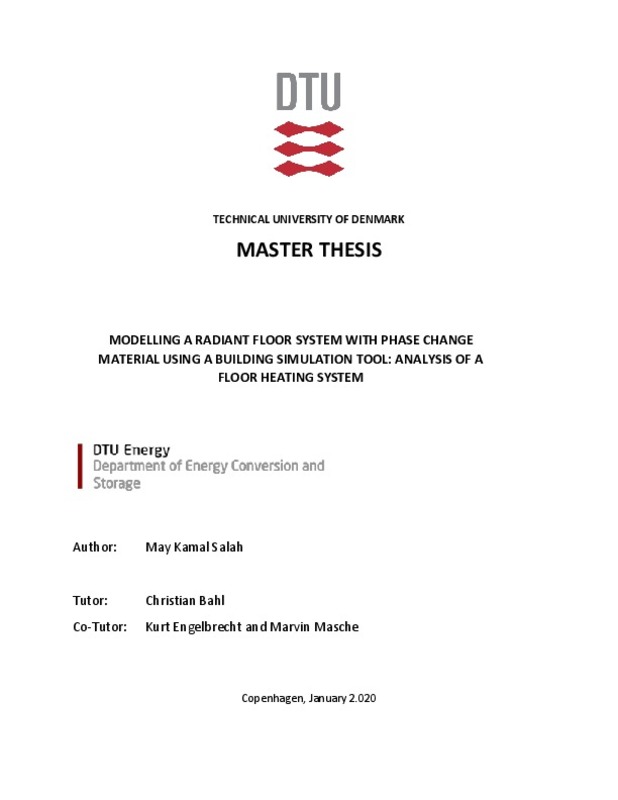JavaScript is disabled for your browser. Some features of this site may not work without it.
Buscar en RiuNet
Listar
Mi cuenta
Estadísticas
Ayuda RiuNet
Admin. UPV
Modelado de suelo radiante con material de cambio de fase usando una herramienta de simulación de edificios: Análisis del sistema de calefacción del suelo
Mostrar el registro sencillo del ítem
Ficheros en el ítem
| dc.contributor.advisor | Barceló Ruescas, Francisco
|
es_ES |
| dc.contributor.author | Kamal Salah, May
|
es_ES |
| dc.date.accessioned | 2020-10-13T11:19:47Z | |
| dc.date.available | 2020-10-13T11:19:47Z | |
| dc.date.created | 2020-02-04 | |
| dc.date.issued | 2020-10-13 | es_ES |
| dc.identifier.uri | http://hdl.handle.net/10251/151555 | |
| dc.description.abstract | [EN] In this project, the performance of Phase Change Material (PCM) gypsum wallboard was evaluated in a residential building in Denmark which uses radiant floor as heating system. Different EnergyPlus simulations were carried out to know which melting temperature range leads to the lowest heating demand and total energy consumption. Besides, the location of the PCM, above or below the heating system, was also considered. Different parameters were considered in this study: (1) varying the temperature of the water from the radiant floor; (2) varying the flow from the radiant floor; (3) varying the melting point of the PCM and (4) varying the amount of PCM. After analyzing the first three parameters, a melting point of 23⁰C-24⁰C will be considered as it leads to the lowest heating demand and energy consumption. Finally, the addition of more layers of PCM wallboard leads to 17.9% - 22.2% heating demand savings for constant flow and variable flow, respectively. In the other side, 15.6% - 13.4% energy consumption savings for constant flow and variable flow, respectively. | es_ES |
| dc.description.abstract | [ES] El almacenamiento de energía térmica es esencial para igualar la producción y la demanda, y por lo tanto para proporcionar calor o frío a los consumidores cuando sea necesario de forma independiente. Existen varias formas de cumplir este requisito en los edificios, la más común es un tanque de agua. Pero hay formas más compactas y eficientes, como materiales de cambio de fase (PCM), entre otros. Debido al mayor calor aparente relacionado con el proceso de cambio de fase del material de cambio de fase (PCM), los MPCM han demostrado una mejor capacidad de calor en comparación con el agua. También ha mostrado un mejor rendimiento como almacenamiento de calor y fluido de transferencia de calor secundario. Los intercambiadores de calor de bobina ya se habían utilizado en aplicaciones industriales debido a su alto rendimiento de transferencia de calor.. El propósito de este proyecto simular varios casos en los que se variarán las propiedades del PCM y del sistema de calefacción con el objetivo de obtener mejores eficiencias y menor demanda de calefacción. | es_ES |
| dc.description.abstract | [EN] Thermal energy storage is essential to match production and demand, therefore to provide heat or cold to consumers when necessary. There are several ways to meet this requirement in buildings, the most common is a water tank. But there are more compact and efficient ways such as phase change material (PCM), among others. Due to the greater apparent heat related to the phase change process of the PCM, microencapsulated PCM have demonstrated a better heat capacity compared to water. It has also shown a better performance as heat storage and secondary heat transfer fluid. The purpose of this project is to simulate different cases where the properties of the PCM as well as the heating system will vary in order to achieve better efficiencies and a lower heating demand. | es_ES |
| dc.format.extent | 0 | es_ES |
| dc.language | Inglés | es_ES |
| dc.publisher | Universitat Politècnica de València | es_ES |
| dc.rights | Reserva de todos los derechos | es_ES |
| dc.subject | Materiales de cambio de fase | es_ES |
| dc.subject | PCM | es_ES |
| dc.subject | Materiales magnetocalóricos | es_ES |
| dc.subject | MCM | es_ES |
| dc.subject | Eficiencia energética | es_ES |
| dc.subject | Calentamiento | es_ES |
| dc.subject | Energy plus. | es_ES |
| dc.subject | Phase change materials | es_ES |
| dc.subject | Magnetocaloric materials | es_ES |
| dc.subject | Energy effiency | es_ES |
| dc.subject | Heating | es_ES |
| dc.subject.classification | MAQUINAS Y MOTORES TERMICOS | es_ES |
| dc.subject.other | Máster Universitario en Tecnología Energética para Desarrollo Sostenible-Màster Universitari en Tecnologia Energètica per Al Desenvolupament Sostenible | es_ES |
| dc.title | Modelado de suelo radiante con material de cambio de fase usando una herramienta de simulación de edificios: Análisis del sistema de calefacción del suelo | es_ES |
| dc.type | Tesis de máster | es_ES |
| dc.rights.accessRights | Abierto | es_ES |
| dc.contributor.affiliation | Universitat Politècnica de València. Departamento de Termodinámica Aplicada - Departament de Termodinàmica Aplicada | es_ES |
| dc.contributor.affiliation | Universitat Politècnica de València. Escuela Técnica Superior de Ingenieros Industriales - Escola Tècnica Superior d'Enginyers Industrials | es_ES |
| dc.description.bibliographicCitation | Kamal Salah, M. (2020). Modelado de suelo radiante con material de cambio de fase usando una herramienta de simulación de edificios: Análisis del sistema de calefacción del suelo. Universitat Politècnica de València. http://hdl.handle.net/10251/151555 | es_ES |
| dc.description.accrualMethod | TFGM | es_ES |
| dc.relation.pasarela | TFGM\122460 | es_ES |
Este ítem aparece en la(s) siguiente(s) colección(ones)
-
ETSII - Trabajos académicos [10404]
Escuela Técnica Superior de Ingenieros Industriales






